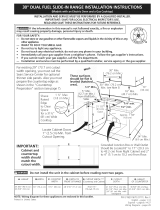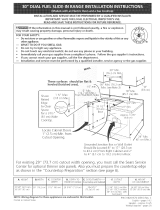
2
30" DUAL FUEL RANGE INSTALLATION INSTRUCTIONS
(Model with Electric Oven and Gas Cooktop)
Important Notes to the Installer
1. Read all instructions contained in these installation
instructions before installing range.
2. Remove all packing material from the oven
compartments before connecting the electrical supply
to the range.
3. Observe all governing codes and ordinances.
4. Be sure to leave these instructions with the consumer.
5. Note: For operation at 2000 ft. elevations above see
level, appliance rating shall be reduced by 4 percent
for each additional 1000 ft.
Important Note to the Consumer
Keep these instructions with your owner's guide for future
reference.
IMPORTANT SAFETY
INSTRUCTIONS
Installation of this range must conform with local codes
or, in the absence of local codes, with the National Fuel
Gas Code ANSI Z223.1—latest edition.
When installing in a manufactured (mobile) home,
installation must conform with Manufactured Home
Construction and Safety Standard, title 24CFR, part
3280 [Formerly the Federal Standard for Mobile Home
Construction and Safety, title 24, HUD (part 280)] or,
when such standard is not applicable, the Standard for
Manufactured Home Installation, ANSI Z225.1/NFPA
501A-latest edition, or with local codes.
This range has been design certified by CSA
international. As with any appliance using gas and
generating heat, there are certain safety precautions you
should follow. You will find them in the Use and Care
Guide, read it carefully.
•Besureyourrangeisinstalledandgrounded
properly by a qualified installer or service
technician.
•Thisrangemustbeelectricallygroundedin
accordance with local codes or, in their absence,
with the National Electrical Code ANSI/NFPA No.
70—latest edition.
•Makesurethewallcoveringsaroundtherange
can withstand the heat generated by the range.
•Aircurtainorotheroverheadhoods,whichoperate
by blowing a downward air flow on to a range, shall
not be used in conjunction with gas ranges other
than when the hood and range have been designed,
tested and listen by an independent test laboratory
for use in combination with each other.
•Beforeinstallingtherangeinanareacovered
with linoleum or any other synthetic floor
covering, make sure the floor covering can
withstand heat at least 90°F/32°C above room
temperature without shrinking, warping or
discoloring. Do not install the range over carpeting
unless you place an insulating pad or sheet of 1/4"
(6.4 mm) thick plywood between the range and
carpeting.
•Donotobstructtheowofcombustionairatthe
oven vent nor around the base or beneath the
lower front panel of the range. Avoid touching the
vent openings or nearby surfaces as they may become
hot while the oven is in operation. This range requires
fresh air for proper burner combustion.
Never leave children alone or
unattended in the area where an appliance is in
use. As children grow, teach them the proper, safe use
of all appliances. Never leave the oven door open when
the range is unattended.
Stepping, leaning or sitting on the
door of this range can result in serious injuries and
can also cause damage to the range.
•Donotstoreitemsofinteresttochildrenin
the cabinets above the range. Children could be
seriously burned climbing on the range to reach items.
•Toeliminatetheneedtoreachoverthesurface
units, cabinet storage space above the units
should be avoided.
•Adjustsurfaceburneramesizesoitdoesnot
extend beyond the edge of the cooking utensil.
Excessive flame is hazardous.
• Do not use the oven as a storage space. This
creates a potentially hazardous situation.
•Neveruseyourrangeforwarmingorheatingthe
room. Prolonged use of the range without adequate
ventilation can be dangerous.
•Donotstoreorusegasolineorotherammable
vapors and liquids near this or any other
appliance. Explosions or fires could result.
•In the event of an electrical power outage, the surface
burners can be lit manually. To light a surface burner,
hold a lit match to the burner head and slowly turn
the Surface Control knob to Lite. Use caution when
lighting surface burners manually.
•Resetallcontrolstothe"off"positionafterusing
a programmable timing operation.
•Removebroilerpan,foodandotherutensils
before self-cleaning the oven. Wipe up excess
spillage. Follow the cleaning instructions in the Use &
Care Guide.
To reduce
the risk of tipping of the range,
the range must be secured
by properly installed anti-tip
bracket (s) provided with the
range. To check if the bracket
is installed properly, grasp the
top rear edge of the range and
carefully tilt it forward to make
sure the range is anchored.
• All ranges
can tip.
• Injuryto
persons
could result.
• Installanti-
tip device
packed with
range.





















